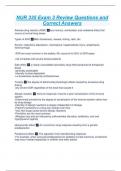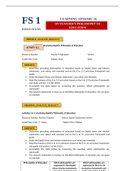Exam (elaborations)
NUR 335 Exam 3 Review Questions and Correct Answers
- Course
- Institution
Adverse drug reaction (ADR) any noxious, unintended, and undesired effect that occurs at normal drug doses Types of ADR Mild: drowsiness, nausea, itching, rash, etc. Severe: respiratory depression, neutropenia, hepatocellular injury, anaphlyaxis, hemmorrhage -ADR are most common in the elderly; ...
[Show more]




